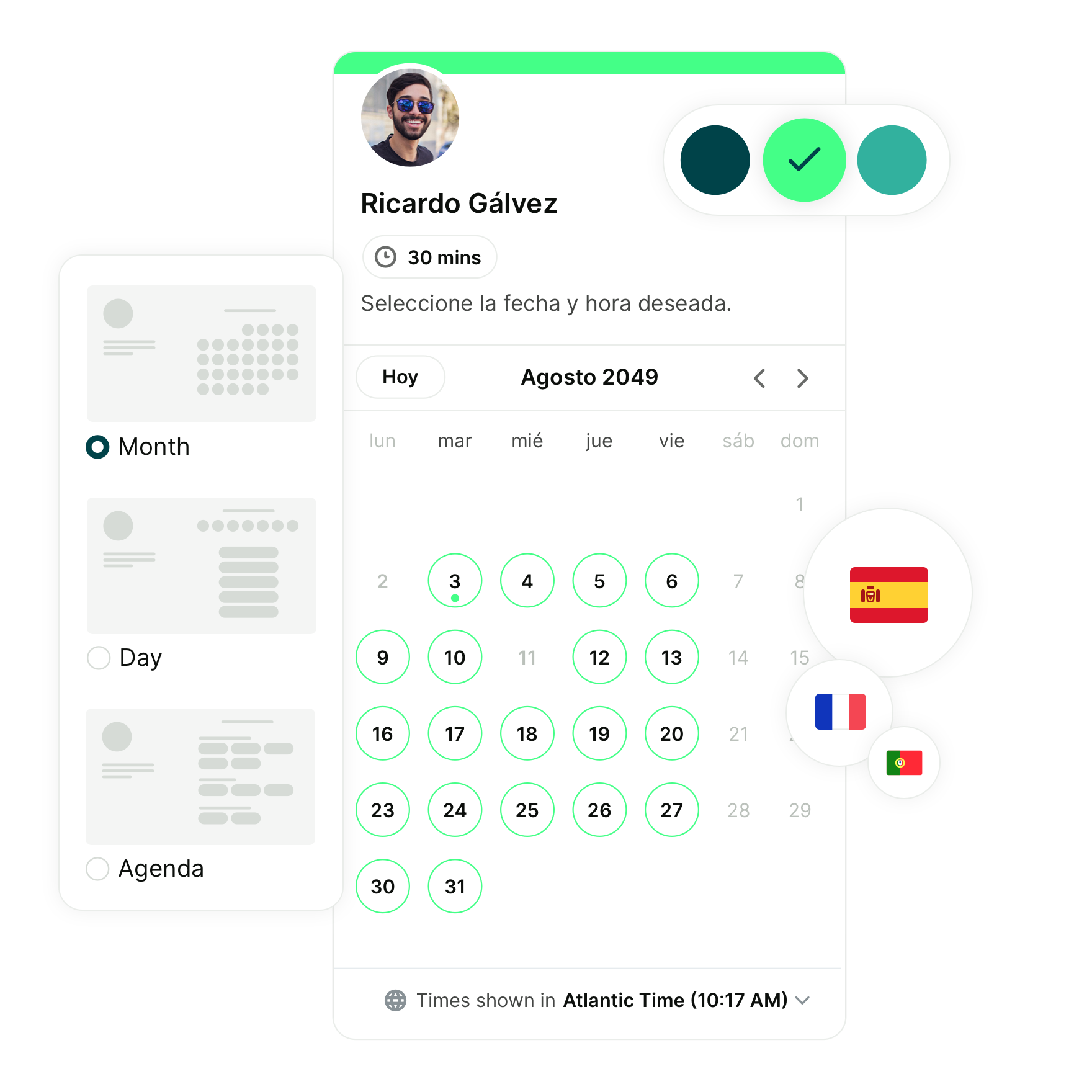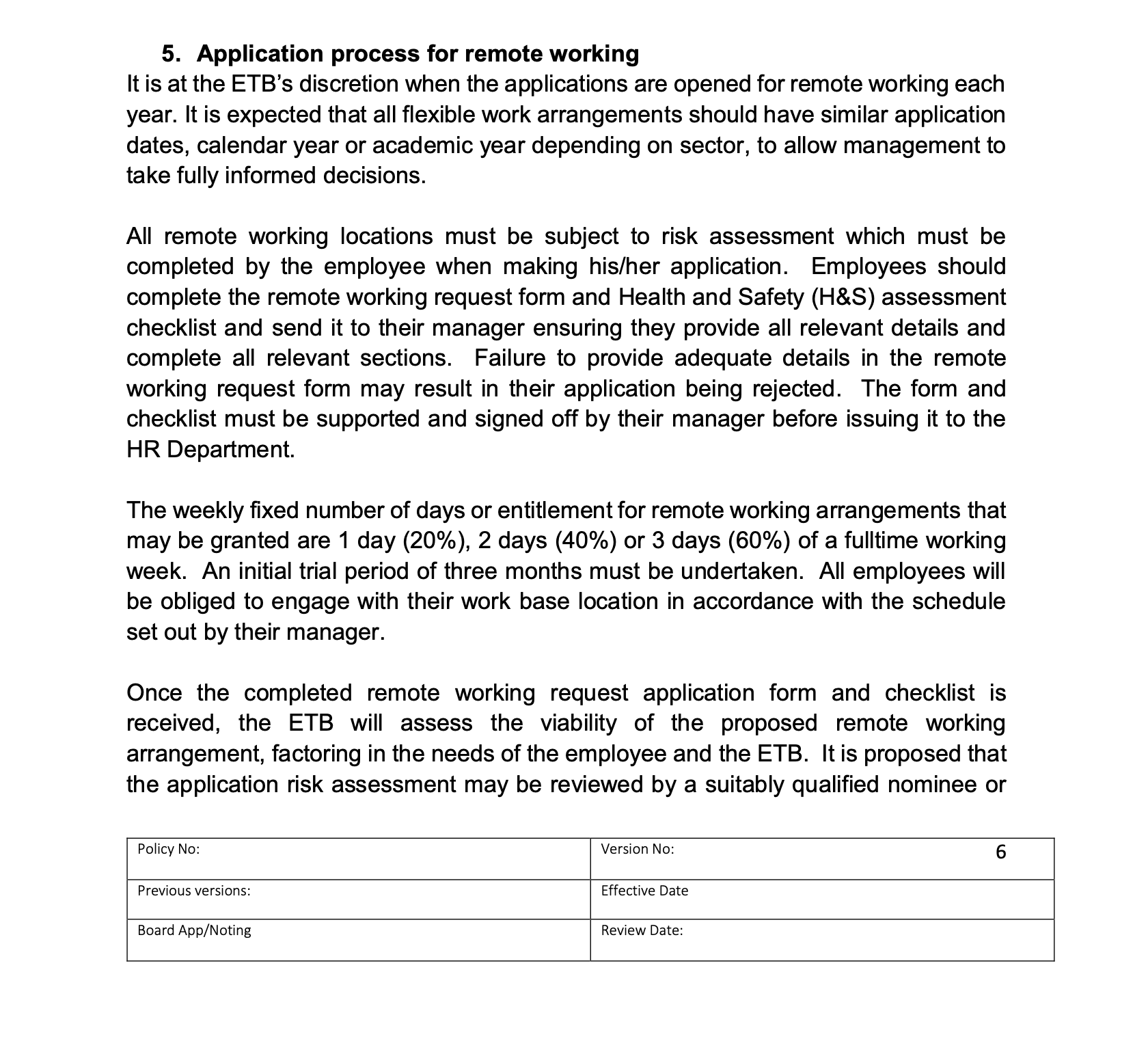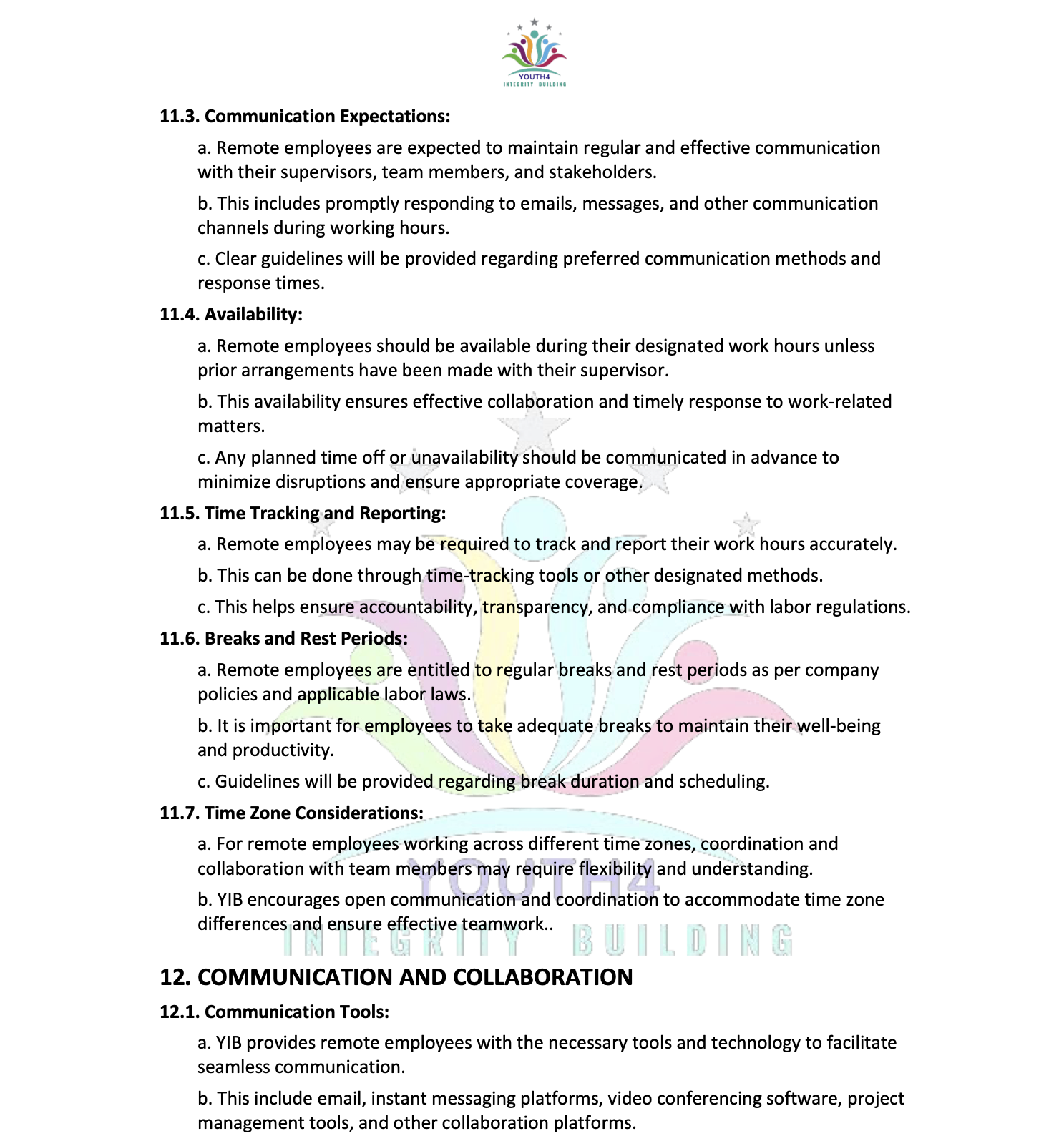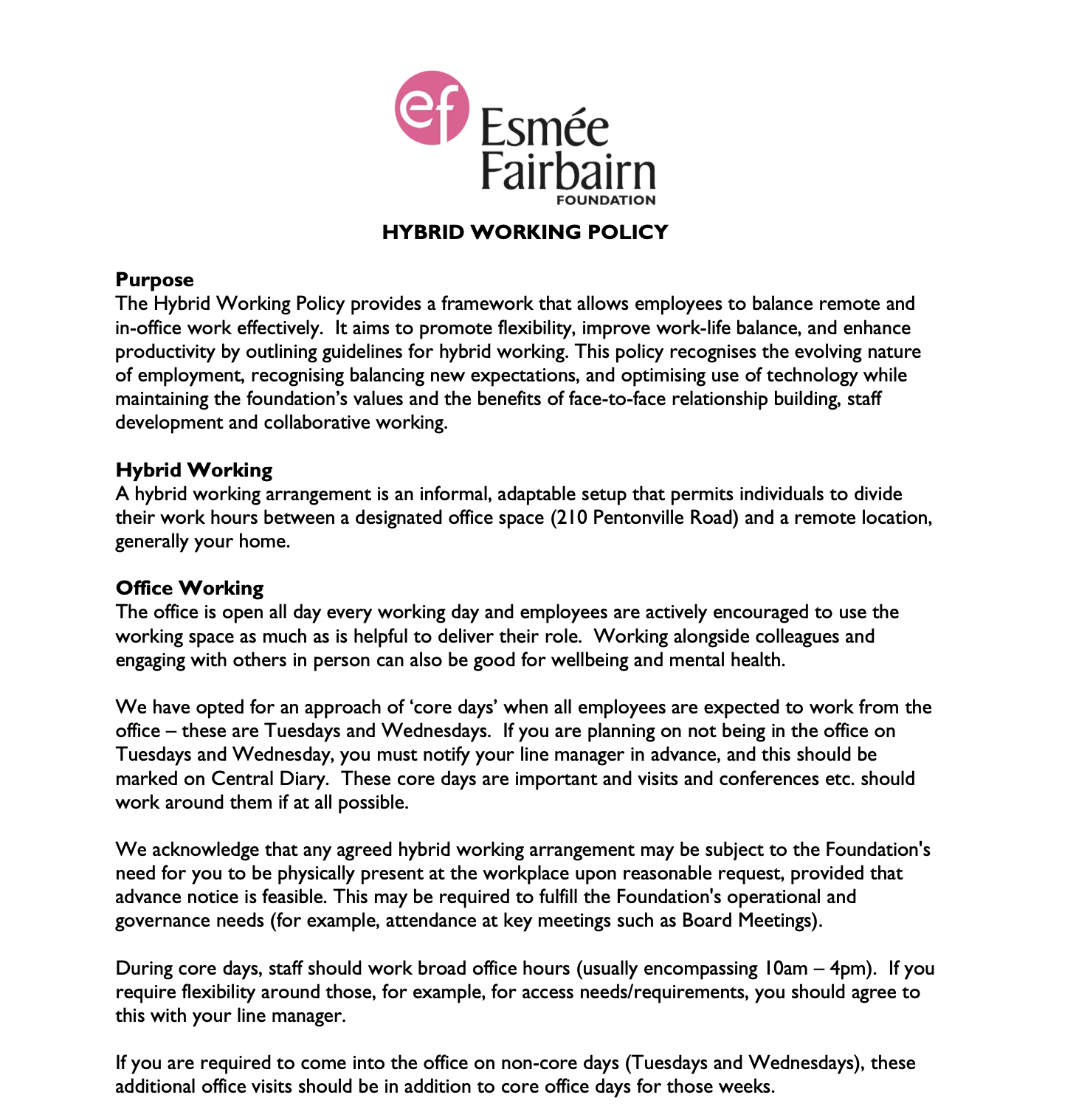The Best Remote Work Policy Examples You’ll Want To Copy
Learn how to write a remote work policy that works for you and your team.

Paulina Major

Ready to book more meetings?

“Sure, we support remote work.” But what does that actually mean in your business?
If you’re still relying on vague guidelines or verbal agreements, a written remote work policy is a must. Just like any other workplace policy, really! Without one, misunderstandings can pile up about employee availability, tools, data security, or even who’s allowed to work remotely in the first place. A clear policy not only sets expectations but also protects your business legally and keeps your team aligned.
This guide walks you through how to create one, with real-world examples and a free, downloadable template.
Let’s jump right in!
What is a remote work policy?
A remote work policy is a set of rules that explain how your team can work from home or anywhere outside the office.
It covers things like:
- Who’s allowed to work remotely
- How often they can do it
- What hours they should be available
- What tools they need to use
It also includes important stuff like how to stay in touch with the team and how to keep company information safe.
What should you include in your remote work policy?
A solid remote work policy for small businesses sets clear expectations, protects your business, and helps employees stay productive and connected.
Here’s what to include:
Eligibility criteria
Spell out who can work remotely and under what conditions. This might depend on the type of job, seniority, performance, or team needs.
By defining eligibility up front, you reduce the risk of unfair treatment and help managers make consistent decisions. You can also outline whether remote work is available from day one or only after a probation period.
Work hours and availability
Let employees know what hours they’re expected to work. This could be a standard 9–5 or a more flexible setup, but you should define any required “core hours” for team overlap. Also, include clear guidance on:
- Breaks and lunch hours
- Overtime rules and approval processes
- Working across different time zones
- How to request schedule changes or flexible hours
- Expectations for being online during meetings
- How to report sick days or time off when remote
Productivity and performance expectations
Explain how work will be measured when someone’s remote. Will it be based on tasks completed, specific goals, or team KPIs?
Outline how often employees should check in (e.g., daily updates, weekly meetings), and list the tools they’re expected to use, like time trackers or project management software.
Data security and confidentiality
Protect sensitive information by setting clear rules around remote access. Specify whether employees should use company devices, secure networks (like VPNs), and how to handle client or confidential data. Data breaches can be costly and damaging—this section shows employees how to protect both their work and your business. Consider linking to your company’s privacy policy or security training for extra support.
|
🤖 With emerging technology like AI becoming more common, it’s also a good idea to define your company’s AI policy. Use our AI policy template to set clear, simple rules for using the technology safely and effectively. |
Communication protocols
Lay out your expectations for staying in touch. Which tools should your team use, such as Slack, Zoom, email, or phone?
It’s paramount to explain not only which tools to use but also how to use them, for example, when a Slack message is appropriate compared to when a call is necessary. You can also include norms around response times and how meetings should be scheduled.
Technology and equipment support
List what tools or equipment your company will provide, such as a laptop, monitor, or headset, and clarify which costs the employee is responsible for, like internet service or office supplies. This avoids confusion or surprise expenses.
You can also explain how employees can get technical help while working remotely and what to do if their equipment needs to be repaired or replaced.
Location and travel guidelines
Clarify where employees are allowed to work from. Is it just their home? Anywhere within your country or time zone?
Many businesses also set rules for working while traveling, especially internationally, due to tax and legal complications. If your team is allowed to work abroad, include time limits and any approval steps to manage compliance risks.
Termination or policy changes
Let employees know that remote work privileges can be revised or ended at the company’s discretion. Explain how changes will be communicated and what the process looks like if someone needs to transition back to the office. This helps protect your business if operational needs shift or if remote work isn’t working out for a specific employee.
Acknowledgement and agreement
End your policy with a signature section so employees can confirm they’ve read, understood, and agreed to the rules. A signed acknowledgement keeps things clear and documented, which can be helpful for both accountability and compliance. You might also keep a digital copy in your HR system for easy access.
Remote work policy template
Now that you understand the key components of a remote work policy, it’s time to bring them together into a version tailored to your business!
Below is a ready-to-use remote work policy template that covers all the essentials, like eligibility, work hours, communication tools, equipment, and security guidelines. Use it as a base, then edit it to reflect your team's setup, expectations, and workflow.
|
Remote Work Policy Template 1. Policy overview 2. Scope and eligibility 3. Remote work types
Each arrangement must be pre-approved and documented by the employee’s manager. 4. Work schedule and availability 5. Communication expectations
6. Equipment and technology 7. Data security and confidentiality
8. Work location
9. Performance and accountability
Performance concerns will be addressed in line with the company’s performance review process. 10. Changes and termination of remote work 11. Acknowledgement |

Real-world examples of remote work policies
Now that we’ve covered the theory, let’s look at a few real-world examples—and highlight what stood out to us, especially the things they did well.
DDLETB’s remote working policy
The Dublin and Dún Laoghaire Education and Training Board (DDLETB) oversees a broad network of schools, training centers, and educational services throughout Ireland. Their workforce includes many frontline educators and support staff, making remote work a complex and highly structured consideration.
👉 Explore the DDLETB’s full remote working policy.

What they did well: This policy is very structured, and there are a few great takeaways. It walks through a clear process for how employees can request to work remotely, what needs to happen before it’s approved (like safety checks), and how performance will be monitored.
It also includes thoughtful touches like setting minimum requirements for eligibility, requiring a proper desk setup at home, and doing regular reviews to make sure the arrangement still works. If you’re looking for a thorough example to borrow from, especially around legal and safety risks, this one covers it all.
Youth for Integrity Building remote work policy
Youth for Integrity Building (YIB) is a nonprofit dedicated to empowering young people to lead with ethics and social responsibility. Their remote work policy is deeply values-driven, blending flexibility with a strong focus on security, professionalism, and employee well-being.
👉 Check out YIB’s remote working policy.

What they did well: This policy strikes a good balance between trust and structure. It includes clear expectations for communication, time tracking, and eligibility, and outlines a full approval process, from submitting a proposal to signing a remote work agreement. It also shines in areas that many small businesses overlook, like data security, remote onboarding, and how to handle cross-time-zone work.
What makes this especially useful for smaller teams is its attention to people: it encourages well-being, collaboration, and clear roles for HR and managers. If you want a people-first, mission-driven approach to remote work, this one is worth modeling.
Esmée Fairbairn Foundation’s hybrid working policy
Esmée Fairbairn Foundation is a major UK charitable funder focused on supporting environmental recovery, social justice, and vibrant communities. Their team works from a central London office and remotely, supported by a thoughtful and practical hybrid policy that reflects their values of flexibility, equity, and well-being.
👉 Take a look at Esmée’s full policy.

What they did well: This is a people-first hybrid policy with clear expectations and a useful structure. It sets out designated “core days” for in-person collaboration (Tuesdays and Wednesdays), while allowing flexibility around location and hours with manager approval. Staff are supported with equipment, workstation assessments, and clear boundaries for remote work, including expectations around suitable setups and availability.
It also does a great job of weaving in health, safety, and accessibility, offering reasonable adjustments for disabled employees and reminding staff to communicate challenges proactively.
YouCanBookMe remote work policy
YouCanBookMe (YCBM) has been remote from the start. Now part of Capacity, we’ve spent years learning what helps distributed teams thrive—and what doesn’t. Our approach to remote work is shaped less by rigid rules and more by thoughtful, experience-driven cultural norms.
See our policy below👇
|
YouCanBookMe remote working policies • Security & Onboarding – All new employees receive digital credentials for cloud system access and must complete mandatory background screening before starting. • Equipment & Workspace Support – Company provides all necessary equipment and reasonable office furniture to remote employees, plus contributions toward co-working space expenses and home Wi-Fi costs. • Communication Standards – All communication must be recorded, shared, and visible to team members to enable asynchronous collaboration; online meetings are recorded using AI note-taking tools for later review. • Timezone Alignment – Employees are expected to work during overlapping office hours rather than operating as timezone-neutral digital nomads. • Annual Face-to-Face Gatherings – Mandatory yearly "all-hands" in-person meetings in St. Louis for team building, collaboration, and onboarding new members. • Global Employment Strategy – Direct employment of staff in their home countries where possible (particularly European employees), rather than restricting hiring to the company's registered location. • Salary Structure – Strategic decisions made regarding pay rates and salary structures when hiring across countries with varying average compensation levels. • Talent Acquisition – Leverage the global talent pool advantage of remote work while maintaining collaborative working relationships through timezone considerations. |
What we do well (or at least what we think we’ve figured out 😄): Our remote work policy is pretty simple, but it covers the stuff that actually matters. New hires get set up with secure logins and background checks right away, and we send out the gear they need to do the job well, from laptops to decent office chairs.
We care a lot about clear communication, so all our meetings are recorded and notes are taken automatically. That way, no one’s left out, even if they’re in a different time zone. We’re also not into the whole “work whenever” vibe—we like to have overlapping hours so people can actually work together, not just swap messages.
Once a year, we all meet up in person because sometimes the best way to build trust is just hanging out.
It’s a wrap
We hope by now you’ve got a solid idea of what a good remote work policy looks like—and how to create one that fits your team’s size, goals, and work style. Use our template to get started, pull the best ideas from the real-world examples, and don’t be afraid to adapt things as your business evolves.
Once your policy is in place, the next step is making sure your team understands it. A quick training session can go a long way in building clarity and buy-in. With a scheduling tool like YouCanBookMe, it’s easy to set up sessions with your team without all the back-and-forth emails trying to agree on the best time for training. Just share a link and let your team pick a time.
How should employees request to work from home?
If you're the one approving remote work requests or you have an HR person handling them, it’s important to keep the process structured and transparent. Ask employees to submit a written request that includes their reason for wanting to work remotely, proposed schedule, and any other relevant details. If your workplace is more casual, email might be enough. But ideally, use a standard form or template so there’s a clear paper trail in case questions come up later.
Do remote work arrangements affect compensation?
Remote work itself doesn’t automatically change an employee’s compensation, but location can. Some companies adjust pay based on regional cost of living or local market rates, while others maintain standardized salary bands regardless of location.
What rules for remote work should equally apply in the office?
Core rules like meeting attendance, response times, and data security should be consistent across all work environments. Everyone should be expected to join scheduled meetings, reply within reasonable timeframes, and follow the same protocols for handling sensitive information. Tools for communication, file sharing, and task tracking should also be used the same way, whether someone is remote or in-office. Many of these expectations should already be covered in your general employee policies anyway.
Subscribe to our newsletter
Get productivity tips, news, articles and resources.
Written by
Paulina Major
Paulina grew up wanting to be a commercial pilot, but life steered her toward content writing. With a passion for tech and business, she’s found her calling in helping brands share their stories every day. Her non-negotiable? Morning coffee—because nothing starts without that first sip.



